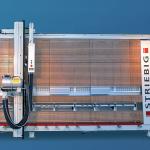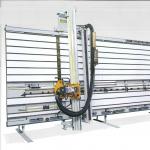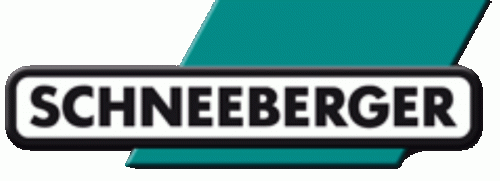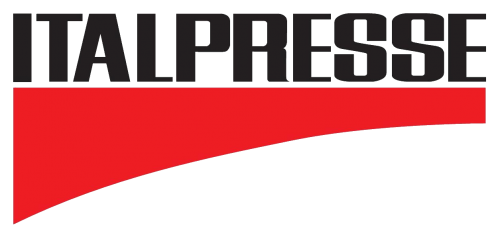Vertical panel sawMachine for cutting derived timber panels, whereby the workpieces are leaned against a standing slatted frame and cut with a tiltable sawing aggregate. The vertical panel saw was invented two times over in 1958 - in Germany by HOLZ-HER and in Switzerland by Schreinermeister Ludwig Striebig, which established today's Striebig AG for the purpose of further developing its vertical panel saws. Both inventions were based on the idea of utilising the workshop space more expediently through vertical panel sizing. Construction and functionalityVertical panel saws comprise the following two main components:
1. Workpiece supportThe workpiece support comprises a solid upper and somewhat lighter lower beam. These are connected with each other via vertical struts and form a torsion-resistant frame. Up to the 1990s, with economical models the slatted frame from wooden slats was mounted directly on the frame. The option evading slatted frame describes a slatted frame, which evades the saw blade when a horizontal cut is implemented in the location of the wooden frame slats. Nowadays, this option is part of the standard equipment of vertical panel saws. 2. Saw carriageThe saw carriage from a solid metal square-section hollow profile runs in a rail on the upper beam of the sawframe and is therefore supported in a vertical direction. Horizontal support is provided at the lower end of the beam by a roller on ball bearings against the lower beam of the sawframe. The beam can be driven to the right and left. The saw aggregate is fastened to the beam. This is driven up and down on the beam for vertical cutting processes. Tilting the aggregate and driving the beam to the right or left results in the horizontal cuts. AutomationWith automatic panel saws the driving movement of the saw carriage and saw aggregate, as well as the plunging movement of the saw blade are motorised. Depending on the degree of automation, the saw aggregate is automatically tilted and the panel sizing is optimised in terms of yield or working speed. PurposeVertical panel saws are used for cutting panels from these materials:
Important options for wood processing
|
Images and Videos
Series (197)

| ADVANCE DS DSX D MULTICUT | TITAN ECOMAT EDGE LIMPIOMAT |

| GMC 166 EM6 KGS 125 BRICO KGS 185 BRICO KGS 220 BRICO KGS 32-19 | KGS 4SE KGS 630S KGS M5 KGS M5-B |



































